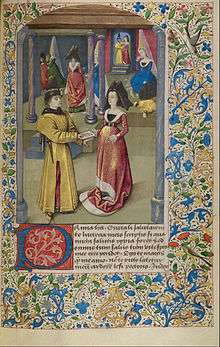The Tale of Two Lovers
 Manuscript of Historiam, containing Euryalus primam epistolam ad Lucretiam mittit (Euryalus Sends His First Letter to Lucretia) | |
| Author | Aeneas Sylvius Piccolomini |
|---|---|
| Original title | Historia de duobus amantibus |
| Language | Latin |
| Genres | Epistolary novel |
| Set in | Siena, Italy |
| Publisher | Ulrich Zell |
Publication date |
|
The Tale of Two Lovers (Latin: Historia de duobus amantibus) written in 1444 was one of the bestselling books of the fifteenth century, even before its author, Aeneas Sylvius Piccolomini, became Pope Pius II. It is one of the earliest examples of an epistolary novel, full of erotic imagery. The first printed edition was published by Ulrich Zell in Cologne between 1467 and 1470.
The novel is set in Siena, Italy and centres around the love story of Lucretia, a married woman, and Euryalus, one of the men waiting on the Duke of Austria. After an uncertain beginning, in which each is in love but unaware that it is reciprocated, they begin a correspondence, which takes up much of the rest of the novel. Before writing his first love-letter, Euryalus quotes Virgil in defence of his position, Amor vincit omnia et nos cedamus amori (translated: "Love conquers all; let us all yield to love!").[1]
The lovers were identified by some with Kaspar Schlick, the chancellor of Sigismund, Holy Roman Emperor and a daughter of the elder Mariano Sozzini, Aeneas' law teacher at the University of Siena. This equation of characters is no longer accepted.
The Latin text was edited most recently in 2001. Translations have been made into several languages, including English.
Notes
- ↑ Verg. Eclogue 10, line 69, quoted by Euryalus in a soliloquy before the first letter.
References
- Morrall, E. J. (1996). "Aeneas Silvius Piccolomini (Pius II), Historia de duobus amantibus". Library. s6-XVIII, 3: 216–29. doi:10.1093/library/18.3.216.
External links
- The Tale of Two Lovers, available at Corpus Scriptorum Latinorum